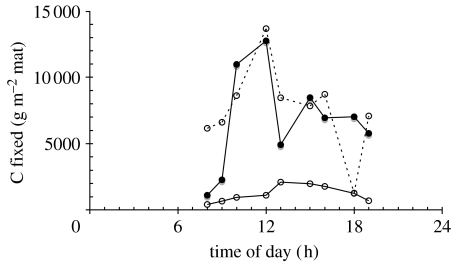Figure 9.
Effect of exogenous fixed carbon on carbon-fixation rates in Nymph Creek (N 44°45.178′, W 110°43.439′), a natural red and green algal ecosystem in Yellowstone National Park, WY, USA. Carbon fixation was measured by the acid-stable incorporation of in situ, as described by Rothschild & Mancinelli (1990) and Rothschild (1991). The incubation mix was stream water (control: filled circle, solid line) or stream water supplemented with 25 mM acetate (open circle, solid line) or 25 mM glucose (open circle, dashed line) and 1 μCi ml−1 14C-bicarbonate (New England Nuclear, Wilmington, DE, USA, catalogue number NEC 086H). Algal mat cores (surface area=17 cm2) were placed in Whirlpack bags, incubation mix was added and the bags were incubated in Nymph Creek. Experiments were conducted in duplicate, and all data points were averaged. Dark controls were performed by wrapping the incubation vessel in foil. The dissolved inorganic carbon of Nymph Creek water was determined using a CO2 probe (Lazar Research Laboratories, Los Angeles, CA, USA) calibrated with aqueous solutions of . Incubation times were 15 min in order to minimize the impact of remineralization of the fixed carbon and to be sensitive to light levels that are constantly changing in nature.

